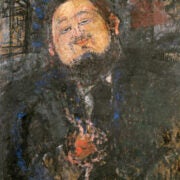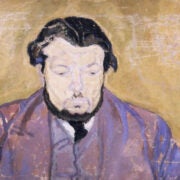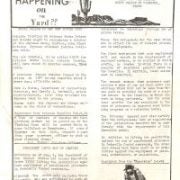Diego Rivera: the artist through his own eyes
Frida Kahlo is world-famous for her self-portraits, which were a big part of her relatively small oeuvre (55 out of 144 paintings), while her husband Diego Rivera, despite producing much more work than Kahlo, only painted himself approximately 20 times. Why is that?

Diego M. Rivera, Frogs; Study for: Carcamo del Rio Lerma, 1951. Image and original data provided by Detroit Institute of Arts, © 2010 Artists Rights Society (ARS), New York
Could it be that Rivera, a large man who described himself as ugly and referred to himself as el sapo— the toad—didn’t like looking at himself? When he does depict himself, Rivera always shows his eyes bulging, and he often sports a slightly sardonic smile. (Might he be mocking himself in the frogs he sketched for the Carcamo del Rio Lerma murals?)
- Leopold Gottlieb, Portrait of Diego Rivera, 1912. Image and original data provided by Detroit Institute of Arts
- Amedeo Modigliani, Diego Rivera, 1914. Image and original data provided by Erich Lessing Culture and Fine Arts Archives/ART RESOURCE, N.Y.; artres.com
- Jacques Lipchitz, Portrait of Diego Rivera, 1913. Image and original data provided by Detroit Institute of Arts
It’s interesting to compare Rivera’s view of himself with how the artists around him saw him. Leopold Gottlieb presents the Mexican painter as a dashing romantic artist, while Jacques Lipchitz shows him as thoughtful and slightly melancholic. Amedeo Modigliani, on the other hand, paints him as a smiling mountain of a man, a broad cartoon that seems closer to Rivera’s unflattering vision of himself. Notably, none of these artists depict Diego’s eyes as bulging.
Even in an innocent-looking self-portrait, such as the one slyly included in the massive fresco Sueño de una Tarde Dominical en la Alameda Central (Dream of a Sunday Afternoon in the Alameda), the artist’s self-effacement shows up. Diego presents himself as a child while his wife Frida is the adult standing behind him, a reference to Rivera’s immaturity in their relationship. Contrast that to Frida’s more loving depiction of their marriage in a canvas from 1931.
Despite his success and influence, Rivera’s view of himself never improved. In one of his last self-portraits, a watercolor from 1954, the dedication reads “para Chapulin de esta cara fea,”— for Chapulin from this ugly face.
Diego Rivera images in Artstor and JSTOR
There are more than 1,300 images of Rivera’s paintings and frescoes and nearly 800 of his works on paper in the Artstor Digital Library. Most of the images in this post come to us from the Detroit Institute of Arts’ Diego Rivera collection (Artstor | JSTOR), which is composed of rare photographs created in conjunction with the artist’s 1986 retrospective; the mural paintings come from the Bob Schalkwijk (Artstor | JSTOR) archives of Mexican art, which includes more than 600 images of Rivera’s work; Frida’s portrait of herself and Diego comes from the San Francisco Museum of Modern Art (Artstor | JSTOR), which includes about a dozen paintings by Rivera; and the Modigliani portrait comes from the Erich Lessing Culture and Fine Arts Archives (Artstor | JSTOR), which also includes a different painting by Kahlo that features her and Rivera.



